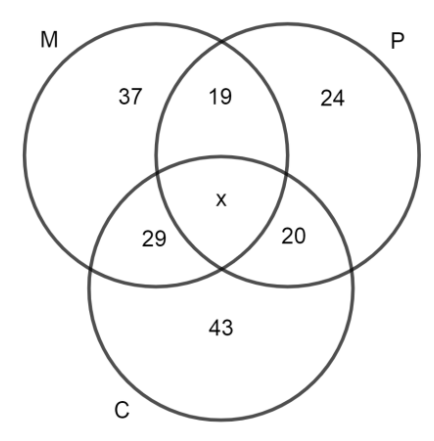
From 50 students taking examinations in Mathematics, Physics, and Chemistry. 37 passed in Mathematics, 24 in Physics, and 43 in Chemistry. At most 19 passed in Mathematics and Physics, at most 29 passed in Mathematics and Chemistry, and at most 20 passed in Physics and Chemistry. Find out the largest possible number that could have passed all three examinations.
A. 11
B. 12
C. 13
D. 14
Answer
489.3k+ views
1 likes
Hint: We will first write all the given information in the question in the form of the sets and then we will apply the given condition that is the number of at most students passed in the two subjects. Then we will apply the inclusion formula that is:
Complete step-by-step solution
Now, let M, P, and C is the sets of students taking examinations in Mathematics, Physics, and Chemistry, respectively.
So, it is given that:
37 passed in Mathematics, therefore:
Now, it is given that the total students taking the examination are 50, therefore:
Now it is given that at most 19 passed in Mathematics and Physics, therefore:

Now, we know that according to inclusion formula:
Now, it is given that:
We will now add these, therefore:
Therefore, we will use equation 1 to replace the left hand side:
Therefore, the largest possible number that could have passed all the three examinations is 14. Hence, the correct option is D.
Note: Remember that Venn diagrams help you picturise what is going on and deriving the appropriate statements, so always draw that for a better understanding of the examiner. The inclusion formula for union is important as there are three sets given, we did not have to be concerned about when there were only two sets. Here, you have to make sure that you consider the less than or equal to condition instead of less than, else you might choose a different option.
Complete step-by-step solution
Now, let M, P, and C is the sets of students taking examinations in Mathematics, Physics, and Chemistry, respectively.
So, it is given that:
37 passed in Mathematics, therefore:
Now, it is given that the total students taking the examination are 50, therefore:
Now it is given that at most 19 passed in Mathematics and Physics, therefore:

Now, we know that according to inclusion formula:
Now, it is given that:
We will now add these, therefore:
Therefore, we will use equation 1 to replace the left hand side:
Therefore, the largest possible number that could have passed all the three examinations is 14. Hence, the correct option is D.
Note: Remember that Venn diagrams help you picturise what is going on and deriving the appropriate statements, so always draw that for a better understanding of the examiner. The inclusion formula for union is important as there are three sets given, we did not have to be concerned about when there were only two sets. Here, you have to make sure that you consider the less than or equal to condition instead of less than, else you might choose a different option.
Recently Updated Pages
Master Class 11 Economics: Engaging Questions & Answers for Success

Master Class 11 Business Studies: Engaging Questions & Answers for Success

Master Class 11 Accountancy: Engaging Questions & Answers for Success

Master Class 11 English: Engaging Questions & Answers for Success

Master Class 11 Computer Science: Engaging Questions & Answers for Success

Master Class 11 Maths: Engaging Questions & Answers for Success

Trending doubts
State and prove Bernoullis theorem class 11 physics CBSE

1 ton equals to A 100 kg B 1000 kg C 10 kg D 10000 class 11 physics CBSE

State the laws of reflection of light

One Metric ton is equal to kg A 10000 B 1000 C 100 class 11 physics CBSE

Difference Between Prokaryotic Cells and Eukaryotic Cells

1 Quintal is equal to a 110 kg b 10 kg c 100kg d 1000 class 11 physics CBSE




